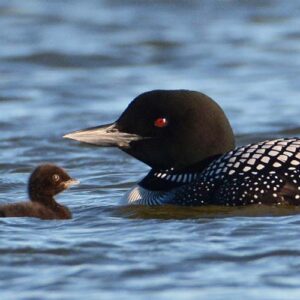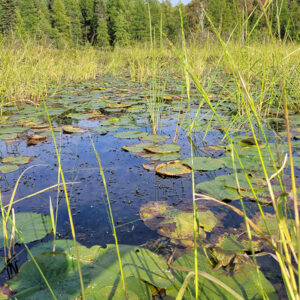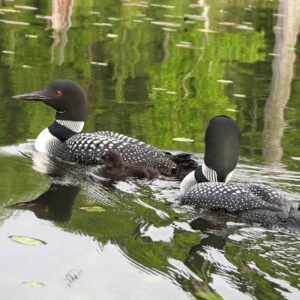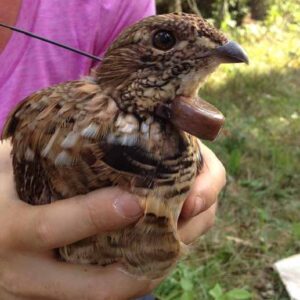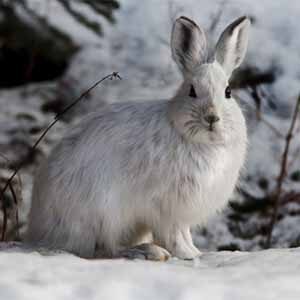WICCI’s Wildlife Working Group investigates how Wisconsin’s changing climate will impact wildlife populations and the habitats they depend on. We bring together managers and scientists interested in understanding and assessing the ecological impacts of modern climate.
One of our most important efforts is the development of climate change adaptation principles to help guide wildlife conservation now and into the future. In doing so, we actively engage with state wildlife managers and organize workshops focused on developing strategies and tactics in climate change adaptation.
Summary of Issues and Impacts
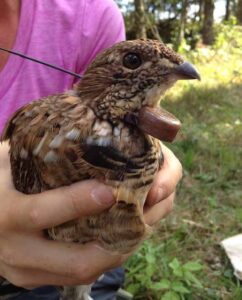
The evidence that wildlife populations are responding to modern climate change is now overwhelming. There is strong scientific consensus that environmental tipping points are being crossed and many species are adapting — or failing to adapt — to a rapidly changing climate. For almost half a century, we have experienced rapidly rising temperatures, extreme weather, shorter winters, and earlier springs.
Ultimately, species have three options in their response to climate change: move, adapt, or face extinction. In Wisconsin, modern climate change has far-reaching consequences, but the consequences of these changes for wildlife vary widely, with some species benefitting and others unable to move or adapt. Whether a species is vulnerable to climate change is determined by their exposure to these changes, sensitivity to weather and climate, and ability to adapt.
To adapt to future climate change, vulnerable wildlife will have to change their behavior, for example to use different foods or migrate earlier, or move to more favorable habitats. Alternatively, wildlife might evolve to better match this new climate space, but this can take many years and multiple generations.
Shifting Ranges
For decades, researchers have documented how Wisconsin’s wildlife is responding to climate change. Many species are shifting their ranges northward to track a changing climate. Winter-adapted species typical of northern Wisconsin are declining and retracting out of the state, whereas warm-adapted species are expanding their ranges.
Loss of Snow Cover
The loss of snow cover is particularly problematic for many of Wisconsin’s wildlife. A shorter winter with less snow deprives many species of an important protection from extreme winter weather and cold snaps. Seasonal snow cover provides important camouflage for species like the snowshoe hare. A deep snow layer also provides a seasonal refuge for birds like ruffed grouse to stay warm during the winter months.
Invasive Species
A changing climate has contributed to the spread of invasive species, and in some cases, increased the risk of disease transmission in wildlife. For example, warmer water temperatures in the Great Lakes contribute to the prevalence of botulism and massive waterbird die-offs.
Other Threats
A changing climate represents a novel pressure for many wildlife communities, and worsens other threats such as habitat loss, pollution, and human-wildlife conflict.
The mission of WICCI’s Wildlife Working Group is to coordinate and share information about climate change impacts and adaptation strategies across the wildlife community and allow wildlife managers and stakeholders to make critical decisions in climate change adaptation.
Ongoing and Future Work
The WICCI Wildlife Working Group is working on the following new projects:
The Adaptive Capacity of Midwestern Fish and Wildlife
The Midwest is facing significant changes in climate conditions (both warming and unpredictable weather) that make it harder to protect wildlife and natural resources. This project will work with partners to explore how different species can adapt to past and future climate changes.
We will identify traits that make some species more resilient, create a framework to make decisions about conservation, and organize workshops to explore how adaptive capacity can better inform the management of fish and wildlife.
Susceptibility of Ruffed Grouse to Changing Wisconsin Winter
This project will study how projected changes in winter conditions affect ruffed grouse. We plan to use climate data like snow depth and weather severity to see how they impact ruff grouse survival and where they live.
We will also track grouse in the field to learn about their survival rates and what causes their deaths. This will help us understand how the ruffed grouse population may react to future winter conditions.
Recommended Solutions/Strategies
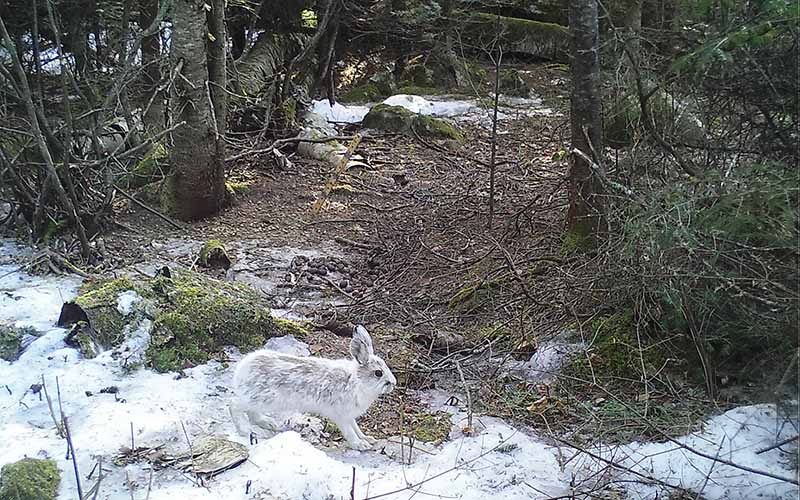
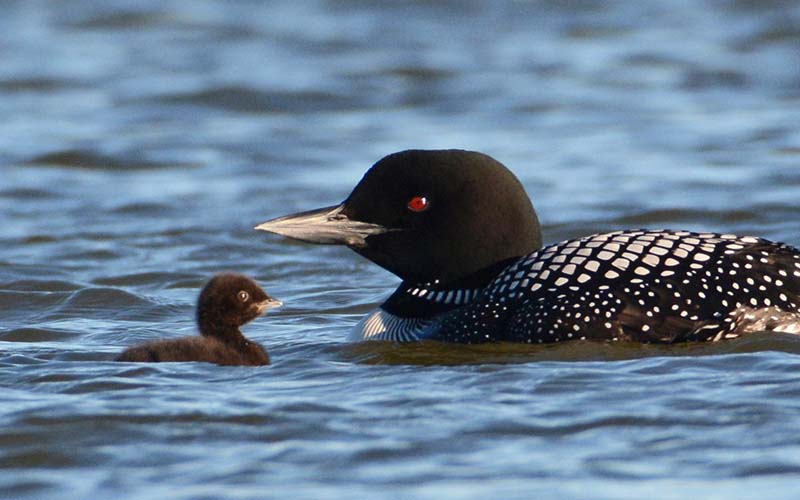
The wildlife adaptation menu is an extensive collection of climate change adaptation actions for wildlife management, organized into tiers of general and more specific ideas. The menu draws upon an extensive literature review that captured adaptation recommendations from scientific publications. For example, adaptation strategies for habitat management include:
- Restore high-quality habitat: Identify and restore degraded landscapes with high potential habitat quality.
- Reduce wildlife barriers: Reduce or limit barriers to wildlife movement across private land.
- Create buffer zones: Manage private lands near and between protected lands to create buffer zones for wildlife.
- Promote sustainable urban landscapes: Enhance green infrastructure and promote sustainable urban landscapes to provide essential habitat and food for local wildlife.
- Support wildlife-friendly farms: Manage public or private agricultural land to provide compatible wildlife use. Wildlife-friendly practices on farms can benefit both wildlife and landowners.
- Create wildlife-friendly forests: Manage forests to provide compatible wildlife use. Forests with a complex structure (with different layers, sizes, density, and a variety of dead wood) can support a greater diversity of wildlife and are more resilient.
Explore More
Environmental and Climate Justice Issues
It is not always immediately clear how wildlife play into environmental and climate justice. The Wildlife Working Group is exploring this topic and continues to discover important interactions. At this time, the Wildlife Working Group has outlined that the effects of climate change are threatening hunting and cultural resource rights, a climate justice concern.
We call for decision makers to consider how the impacts of climate change stress species that are important as game species, which support the economy of rural Wisconsin, as well as important cultural resources, and the rights of Wisconsin’s 11 tribes to continue their cultural practices.
We intend to incorporate elements of conservation relevancy into our working group goals. Broadly defined, conservation relevancy is the notion of enhanced conservation through broadened stakeholder engagement. In the case of the Wildlife Working Group, this could mean engaging with and creating new partnerships with individuals and organizations to advance climate change action and principles that could benefit wildlife and their habitats.
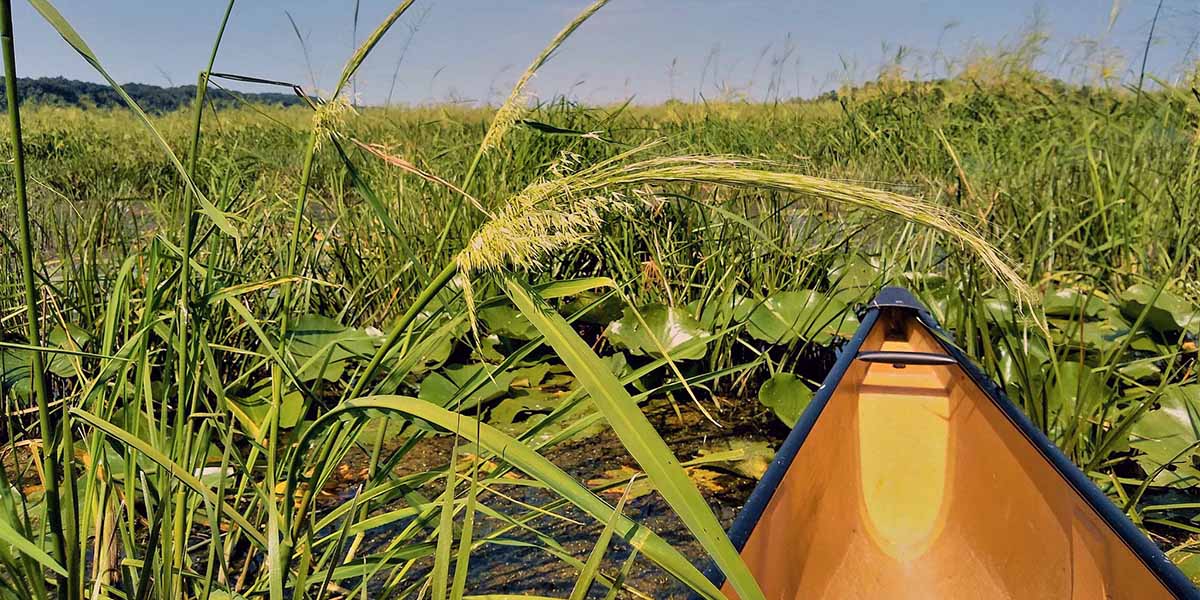
Publications
This is an accordion element with a series of buttons that open and close related content panels.
A Climate Adaption Menu for North American Grasslands
Bernath-Plaisted, J.S., Handler, S. D., Ahlering, M., Brandt, L.A., Maresh-Nelson, S. B., Niemuth, N.D., Ontl, T., Peterson, C.L., Ribic, C. A., Strohmeyer, D., and Zuckerberg, B. 2025. A Climate Adaption Menu for North American Grasslands. Conservation Science and Practice 7(4): e70017
Sweating the Small Stuff: Microclimatic Exposure and Species Habitat Associations Inform Climate Vulnerability in a Grassland Songbird Community
Bernath-Plaisted, J.S., Ribic, C.A., Zuckerberg, B. 2025. Sweating the Small Stuff: Microclimatic Exposure and Species Habitat Associations Inform Climate Vulnerability in a Grassland Songbird Community. Biology Letters 21:20240599
Productivity and Climate Drive Seasonal Trait Turnover and Niche Packing in North American Avian Communities
Keyser, S. R., Pigot, A., Radeloff, V., Pauli, J. N., and Zuckerberg. B. 2024. Productivity and climate drive seasonal trait turnover and niche packing in North American avian communities. Ecology Letters 27(10)
Bird Movements and Migration Under Global Environmental Change: Current and Future Implications
Zuckerberg, B. and La Sorte, B. A. 2024. Bird movements and migration under global environmental change: current and future implications. Frontiers in Bird Science 3: 1470012
Microclimate Complexity in Temperate Grasslands: Implications for Conservation and Management Under Climate Change
Bernath-Plaisted, J.S., Ribic, C.A., Hills, W.B., Townsend, P., and Zuckerberg. B. 2023. Microclimate complexity in temperate grasslands: implications for conservation and management under climate change. Environmental Research Letters, 18: 064023
Preparing Wildlife for Climate Change: How Far Have We Come?
LeDee, O.E., Handler, S.D., Hoving, C.L., Swanston, C.W., and Zuckerberg, B. 2021. Preparing Wildlife for Climate Change: How Far Have We Come? The Journal of Wildlife Management 85(1):7-16.
A review and meta-analysis of peer-review literature related to terrestrial wildlife management in response to climate change that identifies research trends over time, as well as gaps in research and recommendations that could be explored further.
The Past, Present, and Future Impacts of Climate Change and Land Use Change on Snowshoe Hares Along Their Southern Range Boundary
Wilson, E.C., Zuckerberg, B., Peery, M.Z., & Pauli, J.N. 2020. The Past, Present, and Future Impacts of Climate Change and Land Use Change on Snowshoe Hares Along Their Southern Range Boundary. Biological Conservation 249:108731.
Building on their 2016 work related to shifting southern range boundaries for snowshoe hares, the authors investigated the impacts of local forest conditions on hare populations to identify habitat characteristics associated with decline or persistence. By reducing the scale of their investigation, geographically, this study identifies some specific attributes of hare persistence and colonization in particular patches such as harvest-induced early-successional aspen-alder patches.
This study highlights the fact that even for species experiencing significant stressors related to climate change (e.g., phenological mismatch) there may still be habitat management options available that will help species persist and adapt to future conditions.
Climate Change Effects on Deer and Moose in the Midwest
Weiskopf, S.R., LeDee, O.E., & Thompson, L.M. 2019. Climate Change Effects on Deer and Moose in the Midwest. The Journal of Wildlife Management 83(4):769-781.
A review and meta-analysis of peer-reviewed literature related to the impacts of changing temperature and precipitation patterns in the Midwest on white-tailed deer and moose populations in the including habitat changes, physiological effects, pathogen exposure, altered ranges, and species interaction.
Effects of Temperature and Precipitation on Grassland Bird Nesting Success as Mediated by Patch Size
Zuckerberg, B., Ribic, C.A., & McCauley, L.A. 2018. Effects of Temperature and Precipitation on Grassland Bird Nesting Success as Mediated by Patch Size. Conservation Biology 32(4):872-882.
A study investigating the impacts of precipitation and temperature changes on breeding patterns and success rates for grassland birds. Findings showed differences in nest success based on the timing of increased temperature and rainfall, relative to the breeding season. Importantly, patch size was shown to moderate the negative impacts of fluctuations in temperature and precipitation, potentially due to an increased availability of microclimate refugia. This finding highlights the importance of large-scale landscape conservation efforts to increase habitat size and connectivity for increased grassland bird persistence.
Climate Variability Drives Population Cycling and Synchrony
Pomara, L.Y., & Zuckerberg, B. 2017. Climate Variability Drives Population Cycling and Synchrony. Diversity and Distributions 23:421-434.
A study exploring potential drivers of changes in population dynamics for Ruffed Grouse (Bonasa umbellus), an Upper Midwest species in decline. Land use, precipitation, and temperature were all considered as explanatory factors for variability in species survival and reproductive success metrics. Results indicate that increasing variability in winter conditions can disrupt normal population cycling patterns for Ruffed Grouse – particularly in their northern range – and highlights the explanatory potential of incorporating climate projections into population dynamics modeling.
Forest Fragmentation Alters Winter Microclimates and Microrefugia in Human-Modified Landscapes
Latimer, C.E. & Zuckerberg, B. 2017. Forest Fragmentation Alters Winter Microclimates and Microrefugia in Human-Modified Landscapes. Ecography 40:158-170.
A study documenting the impact of forest fragmentation, edge effects, tree size, and urbanization on forest microclimate temperature conditions, and subsequently, on potential persistence of forest bird species dependent on this microclimate refugia. Factors associated with increased disturbance (patches, edges, and smaller tree size) correlated to lower winter forest temperatures, supporting the “leaky landscape” hypothesis that landscapes with increased anthropogenic alterations may be less able to provide adequate winter habitat in the Upper Midwest.
Understanding Climate Adaptation on Public Lands in the Midwest: Implications for Monitoring and Tracking Progress
Anhalt-Depies, C.M., Knoot, T.G., Rissman, A.R., Sharp, A.K., & Martin, K.J. 2016. Understanding Climate Adaptation on Public Lands in the Midwest: Implications for Monitoring and Tracking Progress. Environmental Management 57:987-997.
A qualitative study investigating perceptions of climate change, adaptation planning, and mitigation actions among Upper Midwest land managers. Results indicated that although managers are generally knowledgeable about the impacts of climate change in their region, barriers to action still exist including differing interpretations for climate change adaptation, uncertainty related to potential climate-related management triggers, a disconnect between larger adaptation planning processes and “on-the-ground” management implementation, and the pressure to prioritize actions addressing present problems versus future impacts.
Climate Change Surpasses Land-Use Change in the Contracting Range Boundary of a Winter-Adapted Mammal
Sultaire, S.M., Pauli, J.N., Martin, K.J., Meyer, M.W., Notaro, M., & Zuckerberg, B. 2016. Climate Change Surpasses Land-Use Change in the Contracting Range Boundary of a Winter-Adapted Mammal. Proceedings of the Royal Society B 283:20153104.
A study investigating the factors behind population decline (detection probability) and range shifts of the snowshoe hare – particularly related to southern boundary retraction. Potential drivers explored include historic and project land-use change, forest disturbance, and changes in snow cover depth and duration. Findings revealed a shift in the best predictors for population extinction from reduced forest cover in the past, to climate-driven variables such as snow cover and phenological mismatch.
Barriers to Climate-Adaptive Management: A Survey of Wildlife Researchers and Managers in Wisconsin
Hagell, S., & Ribic, C.A. 2014. Barriers to Climate-Adaptive Management: A Survey of Wildlife Researchers and Managers in Wisconsin. The Wildlife Society Bulletin 38(4):672-681.
A qualitative study documenting important impediments to integrating climate science and adaptation recommendations into management action. Wisconsin wildlife managers, researchers, and administrators were surveyed for their perceptions of climate change risk, communication preferences, and decision-making strategies.
Numerous factors were identified that contribute to a climate adaptation knowledge-implementation gap including temporal discounting (the tendency to under-weight the effects of future events) and underestimation of immediate climate impacts on wildlife populations, differences among sectors related to perception of resource or information needs, and mismatches in terms of communication preferences and products.
This study highlights a number of key impediments to immediate action that can be targeted for improvement in all sectors of climate adaptation (research, management, and administration).
Adapting Conservation Easements to Climate Change
Rissman, A.R., Owley, J., Shaw, M.R., & Thompson, B. 2014. Adapting Conservation Easements to Climate Change. Conservation Letters 8(1):68-76.
An overview of conservation easements (CE) as tools for creating and preserving habitat resilient to climate change. Although easements are popular mechanisms for restricting development, their current structure creates some challenges with regards to climate adaptation including terms that can be constraining for management, conflicting use objectives, and the inability to consistently monitor ecosystem conditions. Alternatives to current CE use are discussed including updated policies, improved consent processes, and tax incentives for active stewardship related to climate adaptation.
Climate Change Impacts on Wisconsin’s Wildlife: A Preliminary Assessment
LeDee, O.E., Hagell, S., Martin, K., MacFarland, D., Meyer, M., Paulios, A., Ribic, C.A., Sample, D., & Van Deelen, T. 2013. Climate Change Impacts on Wisconsin’s Wildlife: A Preliminary Assessment (Technical Bulletin No. 197). Wisconsin Department of Natural Resources.
A comprehensive 2013 assessment of Wisconsin’s ecosystems and wildlife, and potential direct and indirect effects of climate change on those resources. Specific illustrations, based on three habitat types, are provided to demonstrate species and habitat vulnerability to these effects, and adaptation strategies for management are discussed.
Climate Change Vulnerability Assessment: Integrating Scientific and Traditional Ecological Knowledge
Panci H., Montano, M., Shultz, A., Bartnick, T., & Stone, K. 208. Climate Change Vulnerability Assessment: Integrating Scientific and Traditional Ecological Knowledge, Version 1. Great Lakes Indian Fish and Wildlife Commission.
Climate Change Vulnerability Assessment for ceded territories in Wisconsin, Minnesota, and Michigan, uses a combination of traditional ecological knowledge and western science to identify beings (plants and animals) most vulnerable to climate change based on exposure, sensitivity, and adaptability to predicted future conditions. Updated version 2 coming soon.
Our Team
Members
- Benjamin Zuckerberg, Associate Professor, Department of Forest and Wildlife Ecology, UW-Madison, bzuckerberg@wisc.edu
- Chris Ribic
- Jamie Nack, UW-Madison Division of Extension
- John Steigerwalt, Ruffed Grouse Society
- Kelly VanBeek, U.S. Fish and Wildlife Service
- Kurt Waterstradt, U.S. Fish and Wildlife Service
- Mark Witecha, Wisconsin Department of Agriculture, Trade and Consumer Protection
- Michelle Kille, The Nature Conservancy
- Mike Meyer, Wisconsin’s Green Fire
- Olivia LeDee, USGS Climate Science Center
- Shelli Dubay, University of Wisconsin-Stevens Point

